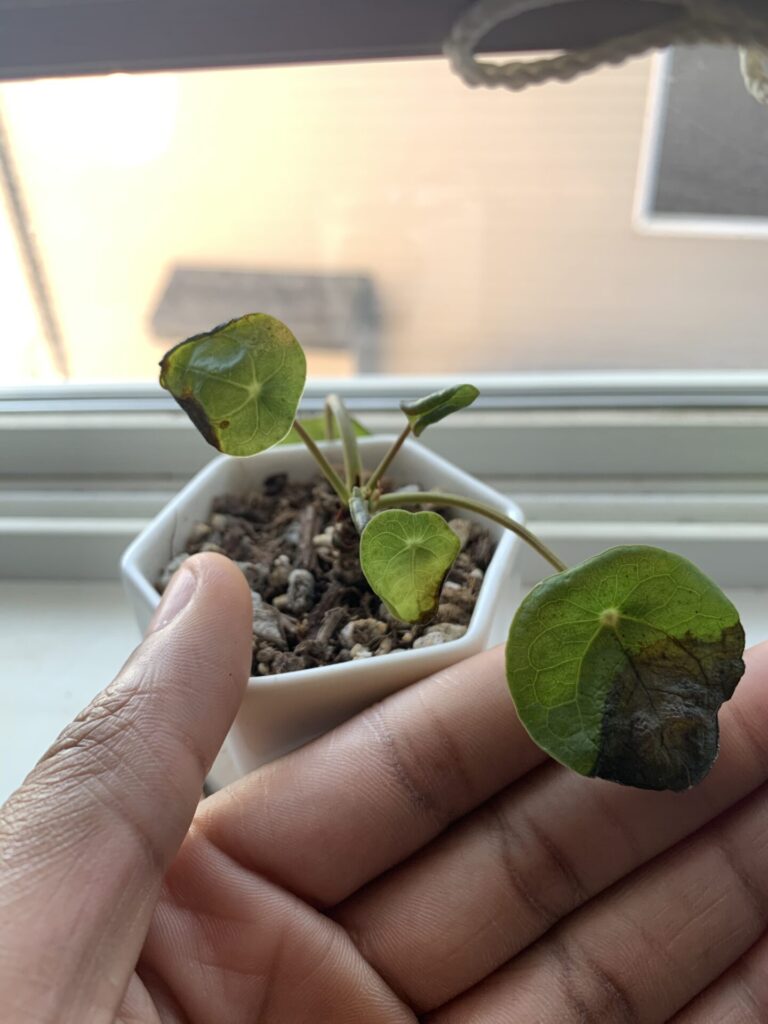
My room window is south facing, meaning in the summer when I got the plant it was doing really well. I fed the plant with a 16-8-25 fertilizer that I had been using for my aloe and it seemed to do good, then I began to notice brown patches appearing on the leaves. After some research, I guessed it was do to fertilizer so I reduced the feeding but nothing changed. I pinched those leaves off and tried to water less, but patched developed on the new leaves. Currently it’s winter so I stopped feeding the Pilea completely, and water much less frequently but it seems like its dying now. There’s black/grey spots on the edges that slowly take over each leaf. I’ve taken off maybe 5 or 6 leaves now– which may have shocked the plant, but I’m not entirely sure.
The plant is currently in a two inch ceramic pot, potted with my own potting mix that seems to drain fairly well (regular soil, perlite, and small pieces of what looks like orchid’s bark).
Any help at all is greatly appreciated, part of me thinks its already too late to save. :(
It sounds like you have enjoyed your Pilea (also called Chinese money plant) over the past few months! I’m sorry to hear it’s not doing well. Over-watering (or poor drainage) and root rot are common culprits in killing Pilea plants.
A couple of issues spring to mind:
- If your ceramic pot does not have a drainage hole in the bottom, water may be trapped inside the pot, causing the plant roots to rot.
- You mention that you make up your own potting mix – I’m not sure what you mean by “regular” soil, but for indoor plants, soil from outdoors should generally not be used, as it tends to become compacted and ultimately does not provide proper aeration or drain well. See University of Illinois Extension’s Using Soil and Soil Mixes
Remember too that the Pilea prefers to stay out of direct sunlight, so indirect light is best (this should not be causing the black leaves though). Also, to remain healthy, your plant should not be located in a draft area or or exposed to lots of heat (e.g., if you have placed it on a radiator). You’re right not to be fertilizing the Pilea outside of growing season.
In the summer, higher temperatures mean that plants tend to need more frequent watering. They are not as needy during the winter and you should allow the soil to dry out between waterings. If you insert your finger to the top of your fingernail (about ½ inch or 1.2 cm) and the soil/growing medium is dry, then it’s time to water. If not, then hold off. If it’s wet or soggy, consider repotting the plant.
Here are links to requests we have answered in the past on the same issue:
- Reasons tips of Pilea Peromioides turn black spots & dry
- Black leaves on Pilea Peromioides
- Pilea Peromioides leaves falling off
If you test the soil and feel that the plant is likely being over-watered and should be repotted, the last link may be particularly helpful. In particular, remove the plant from the pot, cut out the infected plant material (including the rotted roots) and discard, along with as much soil as possible. Allow the roots to remain exposed to the air for a day or so, this will help them to dry out. Then repot using a well-draining potting medium, in a pot that has a drainage hole.
All the best with your lovely plant!
December 21 2020

